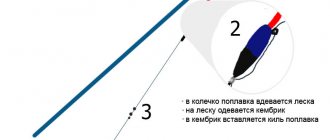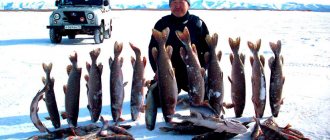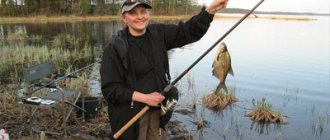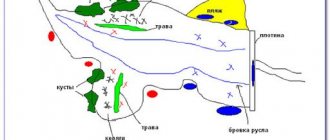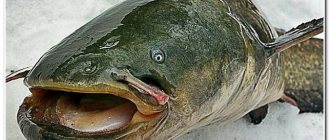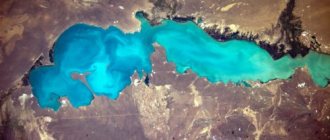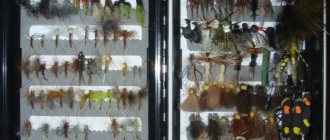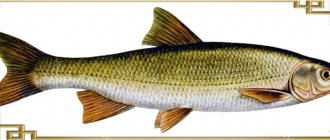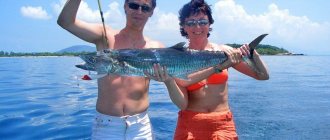Taimen is not just a fish of the salmon family. This is its largest representative, reaching a length of up to 2 meters. Such a fish can weigh up to 80 kilograms. There is an opinion that there are larger taimen, but there is no officially confirmed evidence for this.
Taimen has a slender and beautiful body. Its shape is perfectly streamlined. Narrow and elongated body, covered with small scales. The head of taimen is similar in structure to the head of a pike. After all, it was not without reason that it received the name “red pike” in the Urals. From the sides and top, the head of this fish seems to be slightly flattened. The mouth is large, simply huge, powerful, taking up exactly half of the head. The entire jaw is strewn with sharp large teeth, the ends of which are curved inward.
Taimen is capable of moving very quickly. And its own structure helps it in this - the fins are offset and located near the tail, and their blades are very large. The tail is powerful and strong.
In general, taimen has similarities with salmon and trout. This fish took its enormous size and lifestyle from salmon, and the taimen owes its body structure to trout.
The color of taimen directly depends on its habitat. In general, it is usually silver in color, but can take on brownish-red shades, as well as greenish and grayish. But at the same time, its abdomen is always light, and there are always black spots on its back and sides.
The tail fin is very beautiful - red, with a small notch. The anal fin is the same color. But the dorsal is dark gray, the pectoral and ventral fins are light gray. During spawning, taimen acquires a copper-red color. And young individuals have transverse dark stripes in their coloration.
It is clear that the whole appearance of this fish suggests that taimen is an ideal predator. Large, with a huge toothy mouth and a powerful tail - it knows no competition. No wonder he is called the “master of the rivers.” After all, he eats not only fish. It devours mice and squirrels swimming across the river, waterfowl - ducks, geese, etc. Taimen can even grab a dog, not to mention water rats and other small mammals.
It happened that even stones and sticks were found in the taimen’s stomach. Apparently, this fish doesn’t really know who to hunt. He grabs sticks, confusing them with something living, floating on the surface, but grabs stones, perhaps by accident. Nobody knows.
These fish, as mentioned at the beginning, are of impressive size. They can grow up to 1.5-2 meters in length, and their weight can vary between 60-80 kilograms. But it is clear that such specimens are very rare. Only adult individuals grow to such enormous sizes.
Taimen grows throughout its life, but their life is not always that long. The largest taimen was caught in the Yenisei - 210 cm in length and 105 kg in weight. But this is rather an exception. To gain 45 kg, taimen must live 55 years. And the average size of 7-year-old taimen is 60-70 cm, and weight up to 4 kg. These are usually caught. And until the age of 7, we also need to manage to live with our human needs.
Among salmon fish, taimen can truly be called a giant. It is extremely difficult to catch even a 10-kilogram monster. And taimen weighing more than 10 kg is already considered a piece product.
Taimen is a very strong fish. Large taimen can knock a person out of the boat with one blow of their tail, so be careful, because even experienced fishermen cannot always cope with them.
habits of taimen
Taimen feeds all year round, even in winter, except during the spawning period. After spawning, the time of intense feeding begins. This usually happens in June. But it doesn't last long. For the rest of the summer, the taimen behaves passively and goes to those places where cold tributaries flow and springs flow from the bottom. Because taimen feels better in cool water. In warm water, taimen becomes sluggish and less active.
In the fall, it again begins intensive fattening. This period occurs in September. During this month, taimen behaves very defiantly. It is at this time that he quickly gains weight so that in winter, when food is scarce, he can eat from his fat reserves.
Taimen lives in lakes and rivers. Young fish gather in small schools, while large adult fish prefer solitude, but sometimes form pairs.
Taimen is a “water tiger”, as fishermen also call it. And, perhaps, there is a reason for it. Of course, their main diet is fish. These are perches, minnows, roaches, graylings and others. But this is not the entire list of his diet. Squirrels, mice, frogs, ducks, and geese become its victims. It is dangerous for small animals to be even near water, because at any time a “water tiger” can attack on land, unexpectedly abruptly emerging from the water, like a crocodile.
Young individuals feed on invertebrate animals - caddisfly larvae, for example. They also eat burbot, sculpin, etc. Large taimen will not disdain even their own young.
taimen habitats
Taimen lives in fresh water. He is more comfortable in the northern regions, where rivers flow with cold and clear water. Loves cold-water lakes and fast currents. Never goes to sea. In Russia, taimen are caught over a vast territory - from the Urals (the Pechora and Kama river basins) to the eastern outskirts of Yakutia and the south of the Far East (the Yana, Aldan, Tugur, Uda, Amur rivers with their tributaries).
Taimen is distributed along all significant rivers of the Asian part of Russia, in lakes Baikal and Zaisan, it is found in small quantities in the upper Kama, but much more of it in the tributaries of the Kama - Vistula, Kosa and others, in the Ufa River and its tributaries - Ai, Krasnaya and others , in the upper reaches of the Belaya River with its tributaries, in the upper reaches of the Ob River and its tributaries - Biya, Katun, Veikara, Sobi and others, in the Lozva, Type, Tavda rivers and their tributaries. Taimen is found in the Chusovaya, Vishera and their tributaries.
Quite common in Siberian rivers - Angara, Malaya and Bolshaya Belaya, Onot, Urik, Oka (but in smaller quantities).
In Transbaikalia, taimen is preserved in the Onon and Vitim rivers, but it is noteworthy that on the territory of Mongolia there is much more taimen in the same river.
On the territory of Russia, taimen is also found at the source of the Biya River (Lake Teletskoye, Altai Republic).
In Buryatia, taimen lives in the Uda River. Also caught in the rivers Turka, Barguzin, Maksimikha.
In the Primorsky Territory, it is quite widespread in rivers flowing into the Sea of Japan - Avvakumovka, Margaritovka, Milogradovka, and is also found in Lake Khanka.
An interesting fact is that local residents of Mongolia do not fish where taimen are found. According to local beliefs, if a fisherman catches taimen, he is doomed to disaster.
Taimen are distributed over a wide area from the Urals to Yakutia. These fish live in all major rivers of Siberia and their basins.
There are no taimen only in Indigirka and Kolyma.
The original home of these fish is the Lena, Amur, Yenisei, Podkamennaya and Nizhnyaya Tunguska rivers.
The fish is found in the Lake Baikal basin, in Altai, Sayan Mountains, and in mountainous areas belonging to the South Siberian region. But these places are well developed by humans, so you won’t be able to catch a trophy there. Hundreds of kilometers from large cities, taimen are not found at all.
Taimen also lived in the Volga, which it entered from the Kama. But that was until people built reservoirs and dams.
Taimen loves the cold, but you won’t see this fish outside the Arctic Circle either, even if there are no people there. The fact is that beyond the Arctic Circle the period of open water is very short. During this time, taimen does not have time to accumulate fat in order to feed on accumulated fat reserves in the winter if there is a lack of food. The largest number of individuals live in rivers with a length of 400 to 600 kilometers. And trophy specimens can most likely be found in hard-to-reach places in Evenkia and Yakutia.
Taimen is an object of sport fishing, but in many regions of Russia its removal from a reservoir is illegal. Taimen is included in the Red Book of Russia, the Red Book of the Khanty-Mansi Autonomous Okrug, and the Red Book of the Irkutsk Region. Also in Bashkiria and Komi, this miracle fish is listed in the Red Book.
taimen spawning
Sexual maturity in taimen occurs when it grows to 65 cm in length. Spawning begins in the spring.
At the beginning of spring, after a long winter, fish swim to the upper reaches of the river in which they live. Taimen spawning grounds are established on clean pebble soils without any silt. On the river bottom, the female taimen digs a hole in pebbles up to 50 cm deep. This is the so-called nest, into which the fish lays eggs. The eggs are usually very large and reach up to 5.5 mm in diameter. Lays approximately 10-30 thousand eggs. And the fry usually appear in about a month. It depends on the water temperature.
Spawning grounds are generally always very far from feeding areas. This distance can reach hundreds of kilometers, and taimen in the spring make spawning migrations of enormous length. During their journey, they have to overcome great difficulties and considerable obstacles.
Immediately after spawning, taimen swim to deeper parts of the river. They can stay in pools or holes all summer, until autumn. There they gain strength and gain weight.
And by autumn, taimen leaves these places and begins to move to wintering places.
The color of taimen during spawning is copper-red with tints.
Do not forget that during the breeding season it is prohibited to catch taimen fish.
taimen in the river
Taimen has never been a commercial fish. Since time immemorial, it has been caught only by amateur fishermen. But over time, skills and fishing equipment improve. Human needs are also changing, and not for the better.
People have become so skilled at catching this fish that it has completely disappeared from the western habitats. In other areas, the number of taimen has decreased significantly. And large taimen, where they were found, are said to disappear completely. Therefore, conscious and conscientious fishermen, having caught their trophy, film their feat so that they have something to show their friends and loved ones, or just as a keepsake, and release their catch, having experienced, in their words, extraordinary pleasure. After all, you give life to someone almost equal to you in strength and remain the winner.
Catching taimen without permission is strictly prohibited. Fishermen manage to obtain a permit, which is issued by the relevant authorities, but not in all regions.
Nevertheless, fishing for taimen is very exciting and exciting, because it is the most noble species of salmon, the meat of which is very valuable, pink or red.
Catching taimen is a very exciting activity. This fish will occupy a worthy place of honor in any fisherman’s trophy collection.
Fishing for taimen is one of the most labor-intensive and expensive, but there is little that can compare with it, because it brings amazing sensations.
Nowadays, going for taimen is a real feat, because this fish lives in places where no human has ever set foot.
catching taimen
It is best to catch such a giant in May-June or from late August to November. Fishing is excellent during the post-spawning period, as well as from September until the ice covers the river. These days, taimen feed intensively.
according to fishermen
- Fishermen have long noticed that the best biting times are morning and evening dawns. Frequent bites occur throughout the day, but in cloudy, gloomy, but calm weather, usually in the fall. In sunny weather, taimen take bait much worse.
- When the water becomes cloudy or decreases, the bite usually worsens.
- It has also been noticed that if, when fishing, small taimen (up to 1 kg) are chased and pecked by the lure, then you will not be able to catch a large fish in this place. Because, according to experienced fishermen, large individuals usually travel in pairs, less often alone. And the young animals unite in small flocks. Therefore, the fishing sign that if you catch one fish, then in a short amount of time another of approximately the same size will appear, operates and is based on the lifestyle of this fish.
- Fishermen also believe that during the waning moon, taimen fishes worse than during the new and full moon.
- The most convenient cool time for catching taimen is the morning hours - from 9 to 10 o'clock and the evening hours - from 17 o'clock.
- If the taimen begins to jerk briefly and often float up, then this means that the tee is not inserted well. The fish can easily get away from you. In this case, it is necessary, albeit at risk, to make a second vigorous strike.
Basically, the fish stays at the bottom, so you need to catch taimen from the bottom. On the surface of the water or from the middle, taimen are found less often. Taimen often indicates its presence itself.
Every dawn, with the noise and splash of water, it floats to the surface, can suddenly fly out of the water, and then go back into the depths.
A stunning unforgettable spectacle! It may float up once or twice.
And also on fine days, taimen reveals itself with deafening blows of its powerful tail on the water surface - this is how it chases fish at dawn in calm weather. Where you saw or heard him, you need to catch him.
There are quite enough ways to catch taimen - fly fishing or live bait, spinning with spinners, wobblers and of course with an artificial mouse.
catching taimen using a spinning rod
Taimen are caught using spinning rods mainly with the onset of spring.
Since fishing for taimen involves overcoming long hikes along mountain rivers, the spinning rod should be light and comfortable. Nowadays, light and ultralight class rods are often used. But this is already extreme, it is better to use a mid-class rod. The fishing line is better than “braided”, a time-tested company. The diameter of the line is approximately 0.18 - 0.28 mm.
Experienced fishermen advise using a rod 2.7 m in length or more - you have to cast the bait over a considerable distance. It is better to use a multiplier or inertialess power reel on a spinning rod. And the use by classics lovers of an inertial reel with a large drum of the “Nevskaya” type often leads to serious hand injuries.
You shouldn’t take any tricky modern novelties with all sorts of intricacies. According to fishermen, they often fail at the very peak of fishing.
The material of the spinning rod's passage rings must also be durable, for example, made of silicon carbide (SiC), aluminum oxide (Al2O3).
Please note that there is no need for a leash when fishing for taimen, since this fish is not able to bite through the fishing line, this is the peculiarity of the structure of its teeth.
Also, the success of fishing can largely depend on the carbine. Try to use brass or iron frame molds. This also applies to fishing for taimen in winter.
Use rounded and elongated weights. The bait should be chosen after studying the body of water where you are going to fish. When the river flows intensely, it is preferable to use heavy oscillating spoons. At greater depths, where the current is less strong, large castmasters are suitable. The color of the bait should be natural. You can't fool Taimen. Mostly brass spoons with a yellow tint are used.
spinner for taimen
Mepps Lusox
In summer, it is best to fish with spinners in the early morning or evening before dusk. When the taimen is in its feeding period, it is not at all picky and not very picky about lures; it takes almost everything. But still, the fisherman must have a varied supply of spinners ready. Because taimen, like all fish, can behave in such a way that you can’t figure it out right away. It happens that taimen ignores oscillating spoons, but willingly takes rotating ones. It happens that they bite only on white or only on yellow or two-color baits.
Mepps Syclops
Beginning fishermen often believe that only large spoons are preferred to taimen. But fishing experience shows that even for solid trophies, small “spinners” with a petal length of 40-45 mm can be suitable. Example – Mepps Lusox.
Or oscillating spoons with a length of no more than 90-110 mm. For example Mepps Syclops, Abu Garcia Toby and the like.
The jaws of taimen are very strong and powerful, so carefully check the strength of the tees.
Large spoons, 10-12 cm, should be used closer to autumn. Many experienced spinning fishermen use homemade spinners.
Devonian
For example, Irkutsk fishermen use “Devons” to catch taimen, which are made of tin and painted greenish-brown, with one tee in the tail, which is built in motionless. Now industrial enterprises have begun to produce Devons of excellent quality. The photo on the left is Devon made.
Catching taimen with wobblers gives good results. About fishing with wobblers, see here. In the fall, they are caught using a tackle, with local fish - char. When catching large specimens, you must have a hook.
taimen "on the mouse"
Taimen feeds not only on fish, but also likes to hunt all sorts of small rodents. Witty fishermen have come up with a bait that imitates a mouse. Previously, such bait was made from ordinary wood, which was covered with sandpaper. But over time, new lightweight materials were invented that are currently being successfully used.
"Mouse"
The size of such an artificial mouse for taimen is 10-12 cm and about 50-60 g. The diameter is approximately 5 cm. The “mouse” can be smaller or larger. The shape should be streamlined so that it can glide easily and beautifully through the water, and in principle it is not necessary to imitate whiskers, paws and a tail. You can make a “mouse” with your own hands from cork, hard foam, or sponge rubber. And the blank can be sheathed with the skin of some animal or, in extreme cases, with fabric. To ensure that the “mouse” flies further when casting and does not rotate when moving in the water, a thin lead plate is attached to its abdomen.
They usually catch taimen “with a mouse” in the dark, although during the feeding period he can grab this bait during the day. The “mouse” leaves behind itself a small, but attracting the predator’s attention, groove in the water in the form of a “whisker.” She must stay afloat. The “mouse” is carried through the water more slowly than the spoon.
At the moment of impact, winding should be stopped for a while. As soon as you feel a push (and you will understand it immediately), you need to quickly hook. You need to quickly bring the taimen to the shore and grab it by the back using a hook.
When planning to catch taimen “on a mouse”, it is still necessary to choose the smoothest bank (if possible) while it is still light, a place where there is a quiet current and there are no overhanging plants and bushes.
“On a mouse” taimen goes better on dark nights. In moonlight, bites are uncertain and by no means frequent and may stop altogether.
fishing for taimen
The taimen bite, despite its size and menacing appearance, is cautious. And the grip is sharp. Beginning fishermen often confuse biting taimen with hooking. Then comes the jerk.
You need to hook the fish right away and take the fish out slowly. If the taimen pulls to the side, then you need to slack the line in time, and if the fish goes to the shore, you need to rotate the reel as soon as possible.
Fishing for some trophies can last several hours, taking all the strength and nerves from a satisfied fisherman. The fish rushes madly from side to side, rushing against the current with all its might. And, according to the fishermen, it happens that it sinks to the bottom and, having pulled the fishing line, quickly rushes to the surface of the water and, soaring into the air, strikes with its powerful tail with all its might. Amazing picture! Basically, the fighting area is always limited to the place where it bites.
Taimen often uses a rather cunning technique. It goes to the bottom and lies between the stones. In this case, fishermen drive it to the surface by hitting the rod, but not hard. Or they throw stones, thereby scaring the fish.
An adult taimen that comes off a spoon or is pulled ashore and released usually does not take it again in the near future.
Fishing with spinning rod
This method is used more in open water, with experienced anglers preferring a spinning or oscillating spoon. The first option is best used in cases where the reservoir has a calm current and shallow depth. If fishing for taimen on the river takes place at large drops, then an oscillating spoon is more suitable, since it resembles a small fish fleeing from predators. And this greatly attracts prey.
Catching taimen with a spinning rod on rafts and on riffles involves the use of relatively light gear, since making constant casts with a massive reel and blank will not be easy. The rod needs to be long enough. The fact is that with them the bait is better placed among the stones. When choosing a spinning rod for catching taimen, you should also pay attention to the strength of the guide rings. As for the fishing line, it should be thick so as not to lose the bait.
catching taimen in winter
In general, it is generally accepted that taimen are an exclusively heat-loving fish, and therefore there is no chance of fishing in winter. But everyone knows that the main thing is the desire. Fishermen have proven that taimen bite, albeit not so well, but still take the bait throughout the cold period of the year.
During winter, taimen are more likely to be caught in the northern regions - this is the main condition that must be remembered.
Finding taimen is a simple process, because in Russian reservoirs the water in winter is clean and transparent, and observing fish becomes much easier than in summer.
Tackle for taimen must be chosen based on the experience of professional fishermen who already know everything about such fishing, disappointments and tears of happiness from catching have passed, and who have many kilometers behind them in search of this fish.
For catching taimen in the winter, a girder is well suited; the tackle does not necessarily have to have any special design.
A suitable girder design consists of a strong fishing line and a tee, which is wound on a reel. The bait must be secured on the ice as best as you can, otherwise all the previous efforts put into catching taimen may be in vain. You can also tie the reel to a wooden block, and place it in the hole in a transverse position. Look here at the designs of the vents.
For live bait when catching taimen in winter, large roach, grayling, or lenok are well suited. But fishermen have long noticed that lenok remains active much longer than other fish, so draw your own conclusion.
Remember that the tackle must be checked once a day.
Artificial baits, spinners, and balancers can also do an excellent job. After all, experienced fishermen claim that large taimen are caught well with artificial baits, only for such fishing you will need very strong, reliable and proven hooks.
Beware of hand contact with the fishing line, otherwise serious injury may occur, because taimen bite extremely sharply and powerfully. You need to dampen taimen jerks either with a fishing rod or with the help of a reel brake, which will also come in handy for winter fishing.
You need to drag taimen onto the ice not with the help of a reel, but simply by retreating from the hole. And so that the edge of the ice does not cut the fishing line, the edging of the holes must be rounded. All this, of course, is troublesome. But one wrong step can put your entire fishing trip in jeopardy. If you managed to bring the taimen to the surface of the water, that is, to the hole, carefully pull out the fish using a hook.
Fishing for a mouse
There are several effective ways to catch this representative of the salmon family. It is very interesting to catch taimen with a mouse (that’s what experienced fishermen call this tackle - in the masculine gender, apparently, to distinguish it from live bait) - with an artificial bait five centimeters long, made of cork, wood or foam, and covered for authenticity of appearance fabric or fur.
Fishermen do it themselves. Catching taimen with a mouse is most effective in the autumn months, in particular in September and October. At this time, this representative of the salmon family moves downstream to its wintering grounds. He grabs this bait best in the dark, although during the period of active feeding he attacks during the day.
When using a riding mouse, you need to make sure that it does not hide under the water, but leaves so-called “whiskers” when moving - diverging water paths that will attract taimen. Most often, the predator tries to grab the bait by the head, so tees need to be attached to it on both sides - both in front and behind.
where to catch taimen?
You need to look for taimen near the mouths of small rivers and streams that flow into the river. He can also go into the rivers themselves if they are suitable for his life.
Taimen can stay below the islands on the merging streams that wash the island. This fish also stands in front of and after pits, behind stone slabs lying at the bottom of the reservoir, behind large stones, behind many artificial structures, near riffles or a stormy and strong stream of water, on the banks below and above pits, if they are located in the riverbed .
Taimen are caught in quiet but deep currents, as well as in places where there is a reverse current. You rarely see it in a shallow backwater, but during periods of intense feeding, taimen also enter places unusual for it, actively chasing prey.
The most famous modern habitats of large individuals of taimen are the Yenisei, Lena, Amur basins, as well as Lake Baikal. Unfortunately, the areas of the Sayan, Altai and other mountain systems of southern Siberia are densely developed by humans, and therefore large taimen are unlikely to be found in these places. And around such large cities as Irkutsk, Krasnoyarsk, Ulan-Ude, Yakutsk, Mirny, etc. For hundreds of kilometers, taimen are absent as a species.
The further north you go, the better it is for taimen, as it loves clean, cold and fast northern rivers. But north of the Arctic Circle, taimen are found less and less often. And although many areas of the Arctic Ocean coast are not inhabited by humans, taimen are not there, since the short period of open water is not enough for this fish to accumulate fat, without which it simply will not survive the winter.
In the northern regions there are well-known places where there are a lot of taimen, including large specimens. But they are located in the most remote and inaccessible places of Yakutia and Evenkia. Moreover, taimen can live in rivers of any size, but no less than 400-600 km long.
During the heat, which can come quite unexpectedly in the climate of Siberia, taimen rushes to those parts of the river where there is cold. And these are springs and waters of melted swamps on permafrost. Taimen also stays near the mouth of a cold stream.
Taimen is a large and powerful fish and, according to the law of nature, it requires a large amount of food. And the larger the trophy, the higher the food requirements. Therefore, where there are good reserves of small salmon species such as grayling and many types of whitefish, that’s where you should look for taimen. Where potential food lives - near obstacles in the form of rapids, whirlpools, underwater ridges, sharp changes in depth - there is also taimen.
It has also been noticed by fishermen that if there is something outstanding on the river, for example, a large rapid, a reach, an exposed rock or something similar, then there may be taimen there.
Selection of baits
When choosing baits, at first glance it seems that there should be no problems, since taimen is an unpretentious species of predator and sometimes attacks everything that swims past it. But sometimes he can be very capricious, so it’s better to immediately figure out what baits you should stock up on.
The bait for taimen can be oscillating or rotating. The choice depends on the fishing location. If you have chosen a fast-flowing river, it is better to use a heavy spoon. In calmer bodies of water, medium or large spinners are used. Copper shades work better: matte for clear water, shiny for cloudy water.
The most popular spinners are “pig” and “Kola”, while spinners are “Kem” and “Baikal”. Among the modern models, the Kuusamo Rasanen and Professor vibrators work well, while the Kuusamo Haukilippa and Blue Fox Supervibrax rotators work well.
Since there are still many predators living in reservoirs, it would be nice to stock up on bait for catching them. The arsenal should have a spinner for lenka and taimen, and grayling, and other species. In this case, if you fail to catch the desired prey, you can fish for its smaller counterparts.
If we consider wobblers for taimen, there are also a couple of leaders here. These include minnow class products from the legendary Rapala company, as well as the Crystal Minnow line from the equally famous Yuzuri brand. In addition, the enormous effectiveness of artificial mice is noted.
composition and benefits of taimen fish
The composition of taimen is not as rich as we would like. But it contains something for which all types of salmon are valued. These are polyunsaturated fatty acids (PUFAs), including Omega-3, as well as protein, which is much easier for us to digest than meat protein.
Taimen also contains vitamin PP, macroelements sulfur and chlorine, microelements nickel and molybdenum - in small quantities, more chromium and fluorine, and taimen is quite rich in zinc. Despite the fact that salmon are famous for their rich calorie content, taimen has very few calories - only 88 kcal per 100 g of fish.
The fisherman needs to know that during spawning, taimen meat does not taste great. It contains almost no fat, which is consumed very quickly during this period. The most nutritious middle-aged taimen is not old, but not young either.
Gear selection
Since taimen is a very strong fish and reaches impressive sizes, serious tackle is needed to catch it. In no case should you treat this moment irresponsibly, since on the reservoir you can be left not only without a catch, but also without gear.
A spinning rod must be two-handed. If you have to fight with a trophy specimen, you will need to spend a lot of effort. Sometimes fishing takes several hours. The spinning rod must be durable and light. The recommended length is 3.5 meters. The guide rings of the rod must be steel.
You should also buy a power reel with a gear ratio of 1:3 or 1:2. It must have a large reserve of power and strength. You also need it to be comfortable and hold the required amount of fishing line. Only inertia-free or multiplier products should be considered.
You need to use a thick fishing line with a high breaking load. Products with a diameter of less than 0.7 mm should be discarded immediately. Such fishing lines may not even withstand the first fishing.
Despite the fact that the taimen is similar to a pike in its jaw structure and some habits, it will not be able to bite through the fishing line, so there is no point in using a leash.
Particular attention should also be paid to the choice of hooks. There are no strict requirements here, except for one: the tee must be very durable.
taimen recipes
Many fishermen believe that the best way to prepare taimen is to moderately salt it. With such meat you can even have appetizers, even salads, or even eat it just like that. The main thing is not to spoil it. Do not over-salt or under-salt. But everything comes, as they say, with experience.
There is a dish of Siberian fishermen called “Crystal”. This is a broth for which only heads and fins are taken. This is usually cooked over high heat until done, about 15 minutes. Then cool, filter, add raw chicken protein and a little pressed caviar. After this, the broth becomes clear, like crystal. Then add a couple of hot pepper pods and dill. This broth is not eaten, but drunk with crackers as a bite. If desired, you can also cook “royal” fish soup using this broth, adding pieces of taimen, salmon, sterlet or other noble fish into it.
Between the muscles of taimen there are layers of fat, which is why its meat is so tender. It is this fat, rich in PUFAs, that makes taimen a healthy product.
In Siberia, taimen heads are also eaten, and in their entirety. Usually we throw away the fish offal, and they eat them there too. But they, like the heads, can only be consumed if the fish is very fresh and there is no doubt about it. When the taimen is gutted, the heart, liver, cleansed stomach and bladder are thoroughly washed. And then all this is fried in a frying pan with the addition of a sufficient amount of oil, as well as seasonings and salt until crispy.
Taimen can be bought frozen. It is better to cook this with the addition of carrots, onions, parsley, black peppercorns and allspice. Cut the fish into large pieces and add salted water, add all the other ingredients and cook for about 20 minutes. Usually eaten hot, with potatoes or salad. But if someone likes cold fish, then please, cold taimen goes well with horseradish and fried porcini mushrooms.
Grilled taimen is good. Taimen is also fried on a spit in large pieces, with salt and ground allspice; it is a good idea to drizzle it with melted butter. You can serve with wild garlic, green onions and any fresh vegetables!
Taimen is delicious baked in the oven. It is baked with mustard seeds. Fish fillets are cut into steaks approximately 3 cm thick and weighing less than 100 g. Thickly coat the pieces with mustard seeds, and then breadcrumbs with chopped parsley. Then place in a mold, spread butter on top and place in the oven, heated to 180 degrees. It is recommended to bake for about 10 minutes.
You can also smoke taimen. Smoked taimen is truly considered a delicious delicacy.
taimen fish
Taimen... This “master” of the rivers of the Yenisei, Lena, Amur and other basins is a desirable and prestigious prey for the fisherman.
The law of nature is well known - the larger the animal, the more food it needs. Taimen is very voracious. A predator that keeps all living things in a body of water in fear, because of its instinct, itself becomes vulnerable.
And in this case, sometimes it is important to preserve taimen. After all, it is always pleasant to release a predator into its native element when the winning fisherman gives life to an equal but defeated opponent.
Fishing for taimen is the stuff of legends. From year to year, the taimeniad is replenished with new pages.
Secrets
Large individuals, when attacking a mouse, usually stun it with a blow of their tail, then drown it a little, and then turn around and grab it. Small fish do this right away, on the fly. At the moment of the tail impact, the reeling must be stopped. You need to hook when you feel a characteristic push.
Catching taimen with a mouse works best in a gentle current. You should prepare for it in advance by choosing a flat bank, not covered by vegetation, during daylight hours. In cases where, after hooking, taimen goes to the bottom, the fisherman should expect any “surprises” from the catch. After all, as you know, this large predator is a fairly powerful adversary. Usually he begins to make a sharp throw upstream, and if he fails, he jumps out of the water, shakes his head, and then immediately sinks to the bottom. It is especially important for the fisherman to stop powerful sudden jerks in the first seconds of the fight.

